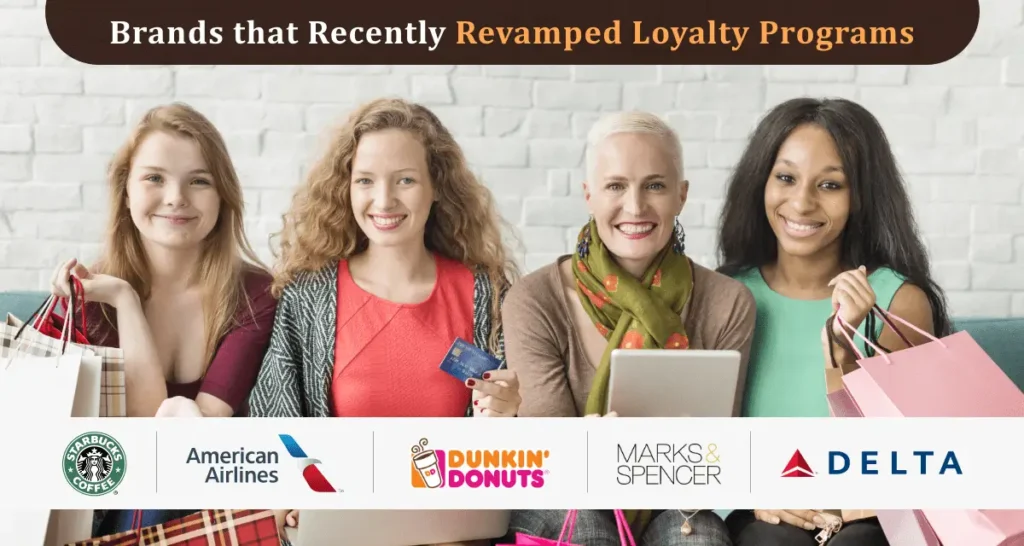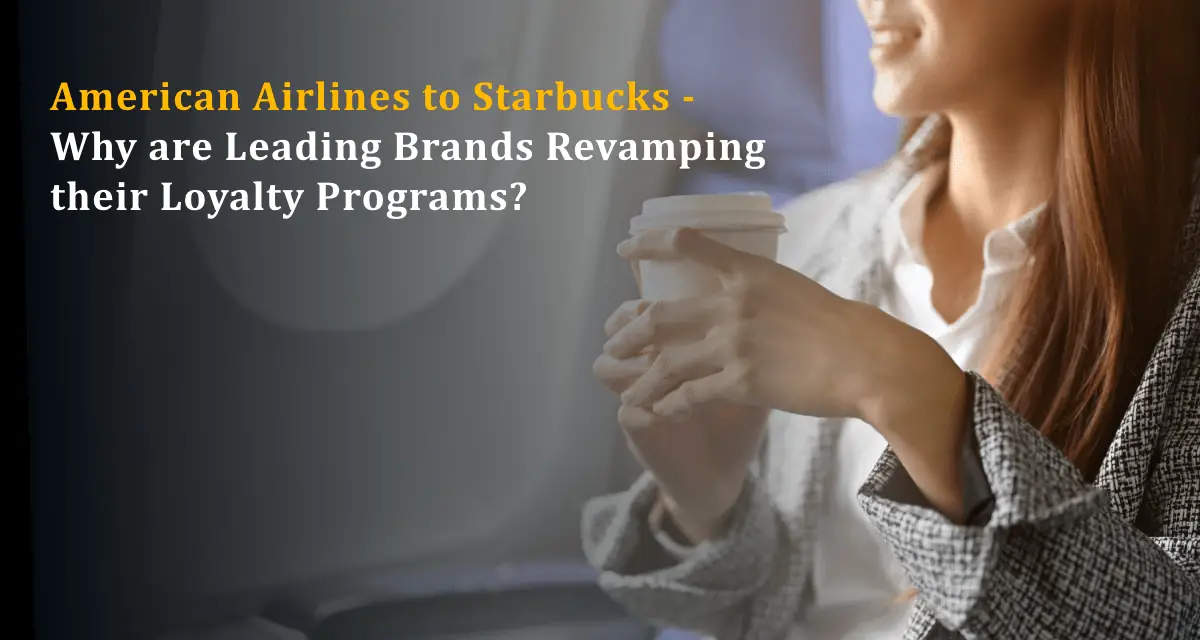Starbucks recently made headlines when it announced its popular loyalty program revamp. Before Starbucks, American Airlines and Delta were trending due to changes in their loyalty programs. As 2022 ended, major brands, including Chipotle, United Airlines, and Amazon, announced changes in their loyalty offerings. 71.6%of brands aim to revamp loyalty programs.
This brings us to the question – Why are brands revamping their loyalty programs?
The most straightforward answer is changing customer behavior paired with changing market scenarios. With inflation, rising costs of living, and digitization, customer behavior has evolved significantly. As a result, customers’ expectations and demands have shifted, causing brands to revamp their loyalty offerings.
Reasons why brands are revamping loyalty programs.
1. Lack of personalization
80% of consumers say they’re more likely to do business with a company that offers personalized experiences. But not every brand has the correct data at the right time & design to provide hyper-personalized loyalty solutions.
The revamp is centralized around a data-first approach by capturing it across customer touchpoints. Nearly 74% of brands prioritize efforts toward data capturing & deep data analytics to personalize the customer experience.
2. Increased competition
With technological innovation, customers are expecting more convenient and seamless experiences. On average, one USA citizen is part of 14 loyalty programs but active in a maximum of 6 programs. Customers are choosing better experiences amidst rising competition in the brand loyalty market.
Brands that fail to keep up with these trends risk losing customers to competitors who offer appealing loyalty platforms. Understanding this, brands are revamping loyalty programs to make them more interactive and engaging.
3. Offer more valuable rewards and experiences
72% of millennials spend more when offered valuable experiences. But, 97% of loyalty programs still rely on transactional rewards. Revamping the loyalty software to incorporate better rewards and relevant experiences can help brands to boost engagement & retention.
Loyalty partnerships, gamification, and integration of charitable associations are some features to have in your loyalty software. It offers members emotional ways to engage with your brand.
4. Rapid technological advancements
Digitization is taking the world by a revolution. Customers prefer digital-first brands because of the “ease of commerce” in this mode. 95% of customers want to engage with loyalty programs using the latest technology, like chatbots, AI, and VR. As a result, many brands have revamped their loyalty program to integrate innovative technology into their loyalty solutions.
For brands, it’s an opportunity to capture data through digital interactions and understand their customer better. A robust technology platform allows marketers to make better marketing decisions and craft targeted campaigns.
5. Boost customer lifetime value
The recent economic crisis has made customers conscious of their interaction with brands. With thousands of brands available at a touch, customers are switching to brands offering better deals.
Morrisons revamped its loyalty program to offer more personalized benefits instead of points. The personalized offering makes customers feel valued and appreciated, allowing brands to foster long-term relationships with customers.

Brands that recently revamped loyalty programs
1. Starbucks
The coffee giant made 2 significant loyalty program upgrades this year. First, it revamped its existing loyalty programs to add more partnerships with the ‘Reward Together’ program. And second, it launched the Starbucks Odyssey loyalty program, introducing NFTs and a digital community for members.
Recognizing the price consciousness among customers during inflation, Starbucks introduced new loyalty partnerships to provide more point-earning opportunities.
Changes in the program include:
- Members will earn 2 stars for every dollar spent.
- Members can now earn points for flying with Delta airlines.
- Customers can now get iced drinks and tea for 100 points instead of the previous requirement of 150 points.
- Members of the Odyssey program can interact with other members in the online community, participate in fun activities and earn NFTs as rewards.
2. American Airlines
The recent revamp of America’s largest frequent flyer program was focused on making it easier for customers to earn rewards. The upgrade enables loyalty program members to earn quickly & reach higher status. The brand added customer-tailored rewards matching their needs. Revamp allows members to earn miles on air and the ground through numerous loyalty partnerships.
Changes in the program include:
- Members have more point-earning opportunities.
- Activities performed during January and February 2022 counts for both 2022 & 2023 status.
- Complimentary upgrade for gold and platinum members.
- Complimentary upgrades are now also extended to 1 companion.
3. Dunkin Donuts
DD perks, Dunkin Donuts’ popular loyalty program, was upgraded to Dunkin Rewards in October 2022. The brand conducted a customer survey asking what customers want from its loyalty programs.
Customers responded with —flexibility, recognition, and variety as key things they look forward to. Dunkin Donuts responded to customer demands by adding more perks and flexibility to earn and redeem points.
Changes in the program include:
- Members can earn 10 points for every dollar spent.
- Members can now redeem food items with points.
- Members can earn triple points on birthdays.
- The points in Dunkin Rewards never expire as long as members stay active.
4. Marks and Spencer
Marks and Spencer recently announced the global launch of its revamped loyalty program — ’Sparks.’ The revamped loyalty program includes tailored offers, customized experiences, and unique perks available to customers globally. The brand created a digital-first customer experience through its loyalty app and Sparks card.
Changes in the program include:
- Members can win free shopping every week.
- Members are rewarded for spending sustainably.
- The store surprises members with little gifts every week.
- Members get access to tailored experiences with the brand’s partners.
5. Delta Airline
Delta Airlines aims to improve customer experience and boost engagement with its loyalty program revamp. By adding a variety of new benefits, Delta ensures that premium tier benefits are accessible and appealing. Delta’s new partnership with Starbucks lets customers earn miles daily while purchasing drinks.
Changes in the program include:
- Delta has introduced choice benefits, including more personalized incentives for premium and diamond members.
- Members can now gift their status to 2 other members.
- Delta allows members to earn more points by linking their Starbucks accounts.
- Members can now redeem miles on checked bags on domestic and international flights.
Some tips to ensure a smooth loyalty program revamp!
- Use deep data analytics to understand what customers want: Revamping a loyalty program without sufficient customer insights can be misleading and adversely hinder growth. A clear understanding of customers’ demands and preferences is of utmost necessity to revamp the rewards program.
- Adopt the latest tech stack: Loyalty programs need continuous upgrades. With innovation in the martech stack, brands should move towards headless commerce, AI/ML algorithms, and omnichannel approaches to stay relevant in the evolving market.
- Have a clear strategy based on previous performance: Monitoring the current program KPIs allows brands to identify top-performing elements. Setting the right goals and KPI metrics ensures that the loyalty program is agile, adaptable, and never out of customers’ preferred choices.
Conclusion
A loyalty program revamp is essential and beneficial for brands. The evolving customer behavior demands change, and brands must be prepared to tackle changes efficiently without disrupting the members’ experience. A proper data-driven strategy with consistent strategic consultation can help brands revamp effectively with signs of rapid growth and consistent results.


